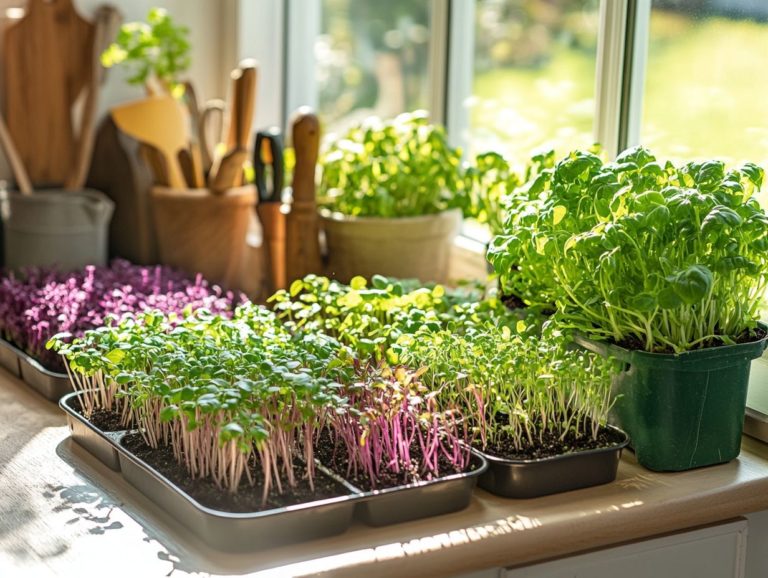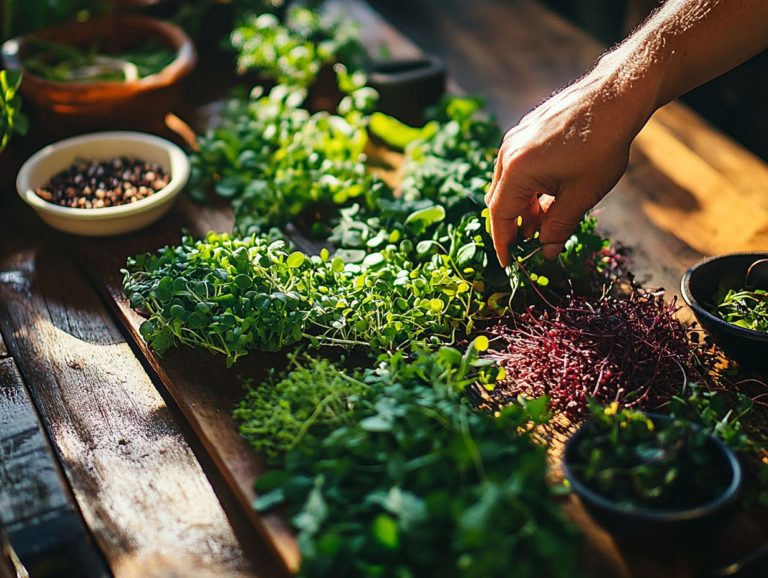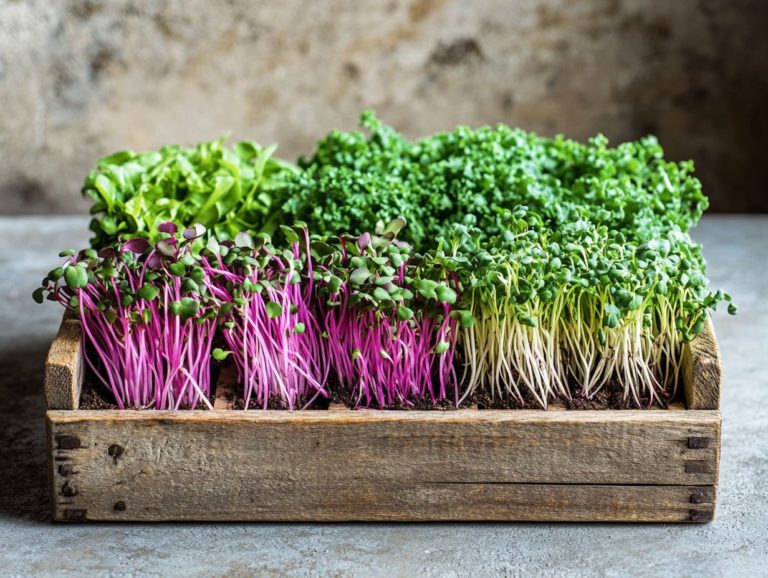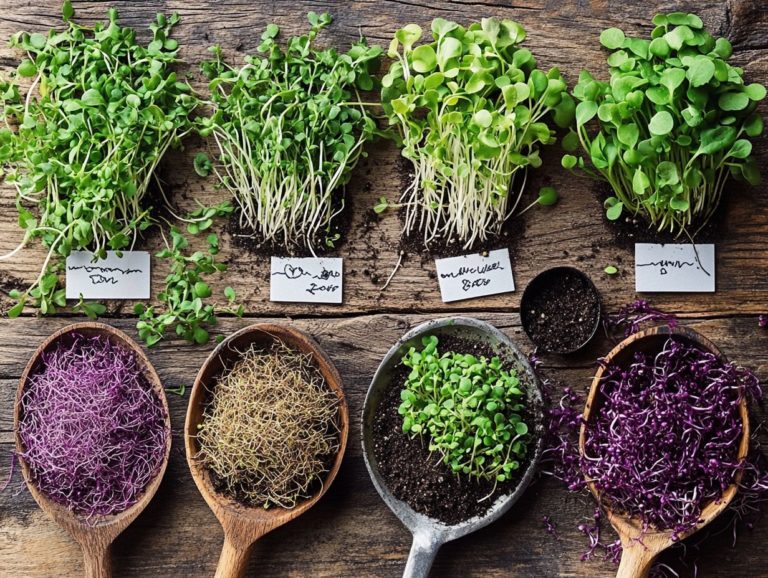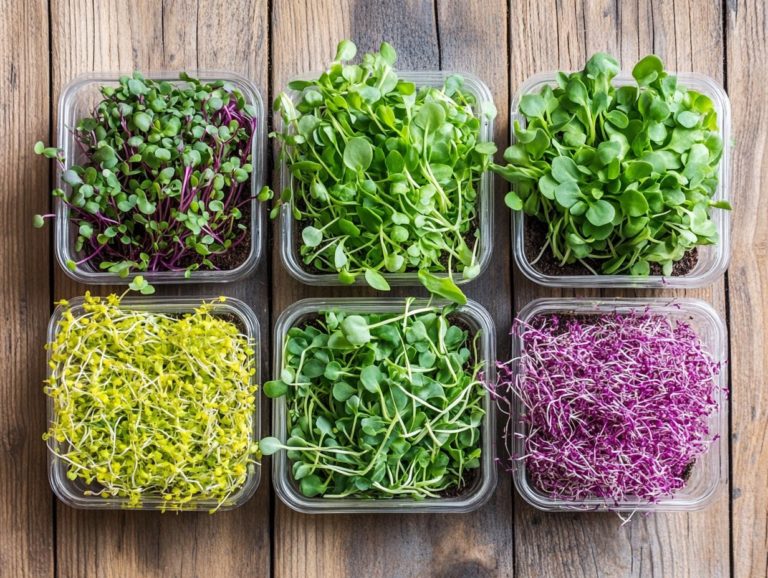5 Colorful Microgreen Varieties to Brighten Your Plate
Microgreens are young plants harvested just after the first leaves develop. They are tiny, flavorful greens that not only pack a nutritional punch but also elevate the visual appeal of any dish you create. Among the best microgreens, their flavor profiles and nutritional benefits make them a popular choice for chefs and home cooks alike.
Consider experimenting with five vibrant microgreens like Red Amaranth, Purple Kohlrabi, Yellow Pea Shoots, and more!
- Red Amaranth
- Purple Kohlrabi
- Yellow Pea Shoots
- Orange Carrot
- Green Broccoli
Each of these not only enhances your meals aesthetically but also offers a significant boost to their health benefits, thanks to their high concentration of vitamins and nutrients.
Explore the world of microgreens understand what they are, learn about their cooking uses, dive into their nutritional advantages, and pick up some tips for growing them right in your own home. These easy-to-grow varieties are perfect for indoor gardening!
Prepare to transform your cooking experience with these delightful additions!
Contents
- Key Takeaways:
- 1. Red Amaranth
- 2. Purple Kohlrabi
- 3. Yellow Pea Shoots
- 4. Orange Carrot
- 5. Green Broccoli
- What Are Microgreens and Why Are They Beneficial?
- Frequently Asked Questions
- What are microgreens and why are they popular?
- What are some examples of colorful microgreen varieties?
- What are the health benefits of incorporating microgreens into your diet?
- How do you grow microgreens at home?
- What are some ways to use colorful microgreen varieties in cooking?
- Are there any precautions or allergies to consider when consuming microgreens?
Key Takeaways:
- Microgreens are a nutrient-packed addition to any plate, including colorful varieties like red amaranth, purple kohlrabi, yellow pea shoots, and more.
- Microgreens are beneficial because they have a high concentration of vitamins, minerals, and antioxidants, making them a preferred choice for health-conscious individuals.
- Microgreens can be used in cooking by adding them to salads, sandwiches, soups, and more for a burst of flavor and nutrition.
1. Red Amaranth
Red Amaranth is not just a visually striking microgreen; it’s a superb nutritional ally for anyone keen on elevating their culinary creations. This vibrant addition brings a wealth of essential vitamins and nutrients.
Its unique flavor makes it an ideal choice for health-conscious individuals. This remarkable plant flourishes under various conditions, typically progressing from seed to harvest in just a few weeks.
Its nutty yet subtly earthy flavor makes it a delightful enhancement to salads, sandwiches, and even smoothies, distinguishing it from more traditional microgreens like broccoli or radish.
Nutritionally, Red Amaranth boasts an impressive array of vitamins A, C, and K, as well as essential minerals such as calcium and iron. This makes it a true powerhouse for those aiming to strengthen their immune system and overall health.
Compared to other microgreens, its unique flavor and vibrant color can elevate both the aesthetic and nutritional quality of your dishes. It gives you a distinctive edge that’s simply hard to resist especially when paired with mustard or pea microgreens.
2. Purple Kohlrabi
Purple Kohlrabi microgreens are not just a feast for the eyes; they are a powerhouse of vitamins and minerals that can transform your culinary creations while enhancing your overall well-being, particularly due to the presence of potassium.
With a crisp texture that echoes a subtly peppery radish, these microgreens deliver a refreshing burst of flavor, perfect for brightening up salads, sandwiches, and smoothies.
They are loaded with vitamins C and K, along with fiber and antioxidants, making them an invaluable addition to any meal.
In your kitchen, the mild, sweet taste of Purple Kohlrabi pairs splendidly with citrusy dressings, nuts, or cheese, enhancing its versatility. Topping a vibrant grain bowl or blending them into pesto can elevate your dishes, creating not just a delightful experience for your taste buds but also a plethora of health benefits.
Try these microgreens today for a boost in taste and nutrition!
3. Yellow Pea Shoots
Yellow Pea Shoots are a delightful microgreen that you can easily grow. They bring a fresh, crisp taste to your salads and sandwiches while offering an impressive array of nutrients. It’s no wonder they ve earned a place in the hearts of home gardeners and chefs alike.
These delicate greens flourish in well-drained soil and prefer cooler temperatures. This makes them perfectly suited for indoor cultivation throughout the year. With their mild, sweet, and slightly nutty flavor, they create a wonderful contrast to the earthy flavors of other pea varieties, such as green peas and snow peas.
Their texture strikes the perfect balance between tender and crunchy. They make an excellent addition to stir-fries, wraps, or even as a garnish for soups. Unlike many other microgreens, these shoots deliver a rich dose of vitamins A and C, making them a healthy choice to elevate your dishes, whether you’re preparing a simple salad or a gourmet meal.
4. Orange Carrot
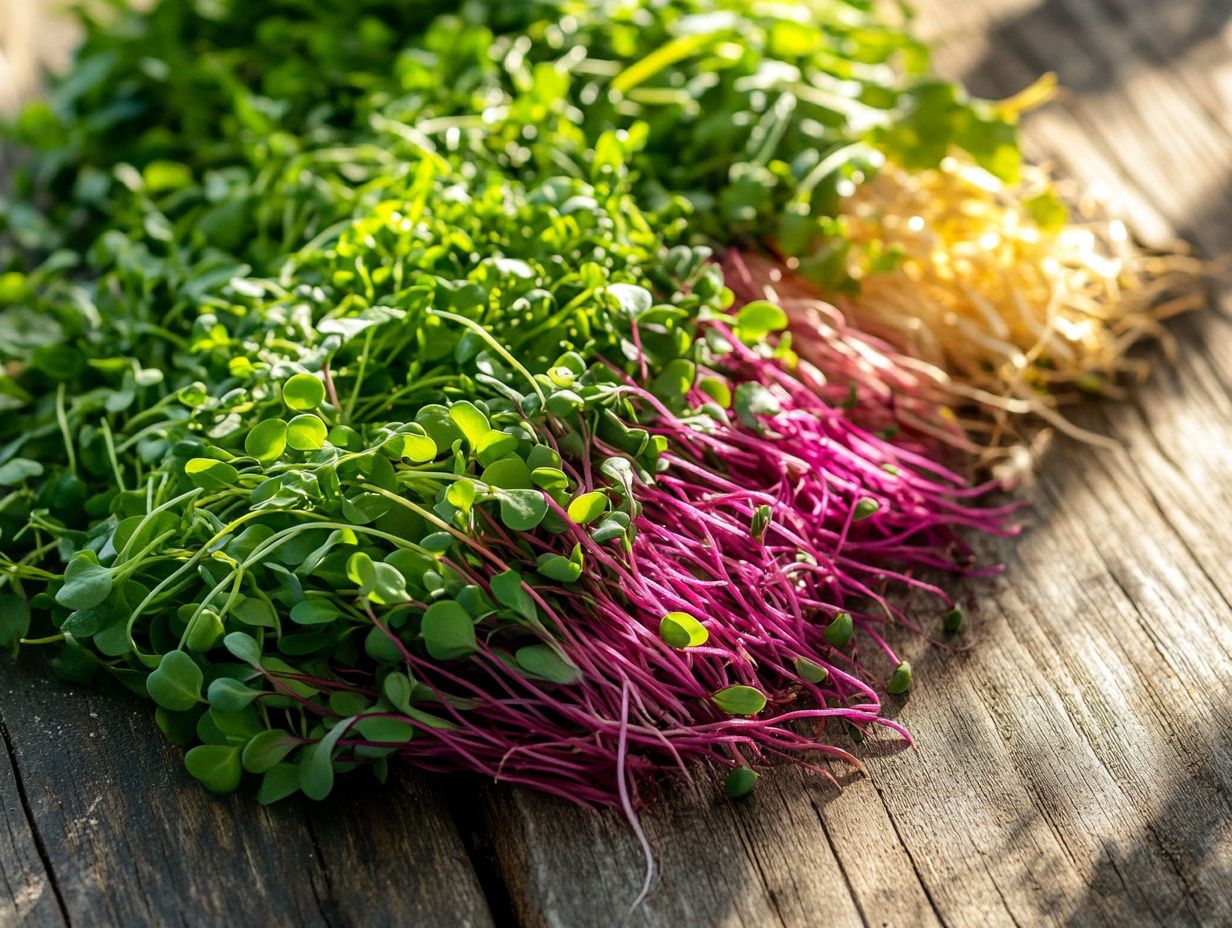
Orange Carrot microgreens present an exceptional opportunity to elevate both the flavor and nutritional profile of your favorite dishes. With their delightful sweetness and vibrant appearance, these microgreens are not just a treat for the palate; they re a powerhouse of vitamins that can enhance your meals in more ways than one.
Packed with essential vitamins A, C, and K, along with valuable minerals like calcium and iron, they are an outstanding addition to any cooking options. Their versatility shines in the kitchen perfect for garnishing salads and soups or adding a burst of color and flavor to sandwiches!
Growing these microgreens at home is straightforward. You simply need a shallow tray, some potting soil, and a sunny windowsill. Compared to other microgreen varieties, Orange Carrot microgreens offer a slightly sweeter and earthy flavor, making them a nutritious choice and a delightful enhancement to your culinary creations.
5. Green Broccoli
Green Broccoli microgreens are esteemed for their remarkable nutritional benefits, boasting high levels of vitamins and antioxidants. When you incorporate them into your meals, they become one of the finest microgreens for enhancing your overall health.
These microgreens serve as a concentrated source of nutrients and bring a delightful flavor to the table. They add a mildly peppery note and a crisp texture to a variety of dishes. You can effortlessly sprinkle them on salads, blend them into smoothies, or use them as a visually stunning garnish for soups and sandwiches.
Compared to leafy microgreens like arugula or spinach, broccoli microgreens stand out with their unique taste profile and exceptional health properties. Their high glucosinolates content supports detoxification, making them a versatile and healthful addition to any culinary masterpiece you create.
What Are Microgreens and Why Are They Beneficial?
Microgreens are delightful, nutrient-packed plants that you harvest at an early growth stage. They offer a remarkable array of health benefits all bundled into a small, flavorful package, making them essential for both your home gardening and culinary endeavors.
You ll typically harvest these miniature greens just after the first true leaves make their debut, which usually happens within 7 to 21 days of germination. The nutritional profile of microgreens is astonishing; they can deliver up to 40 times more vitamins and minerals than their fully grown counterparts.
Take arugula microgreens, for example. They bring a peppery kick to your dishes and are rich in vitamins A, C, and K. Meanwhile, broccoli microgreens are loaded with sulforaphane, an antioxidant that helps boost health.
By incorporating these vibrant greens into your meals, you re not only elevating flavor but also enhancing your overall wellness. Enrich your diet with essential nutrients, including important vitamins like C and A. Try adding these vibrant microgreens today!
How Can Microgreens Be Used in Cooking?
Microgreens offer a world of possibilities in cooking. They can serve as garnishes, flavor enhancers, and nutritional powerhouses, showcasing a variety of flavors from mustard to radish.
Imagine adding these tiny wonders to your salads! Varieties like arugula microgreens infuse a peppery essence, elevating the freshness of your mixed greens. In sandwiches, they can effortlessly replace traditional lettuce, delivering a burst of flavor picture basil microgreens introducing a sweet, aromatic touch.
As garnishes, these vibrant greens can transform a simple soup into a visually stunning masterpiece. For example, radish microgreens lend a peppery kick, turning even basic dishes into gourmet experiences.
With their versatility and unique flavors, microgreens inspire creativity in the kitchen. This ensures every meal is delightful and packed with nutrition.
Discover the Amazing Nutritional Benefits of Microgreens!

The nutritional benefits of microgreens are remarkable. These tiny greens often surpass their mature counterparts in vitamins, minerals, and antioxidants, making them a great help for your health.
For instance, microgreens deliver impressive amounts of vitamin C, vitamin E, and a spectrum of B vitamins, including folate. These nutrients are essential for bolstering immune function and promoting cellular health. They also pack a punch with minerals like iron and potassium.
When comparing microgreens to conventional vegetables, they can boast up to four times the concentration of certain nutrients. This makes them a potent nutritional powerhouse that can elevate a variety of dishes, enhancing both flavor and health benefits.
How to Grow Microgreens at Home
Growing microgreens at home is simple and a gratifying experience. It requires minimal space and resources, making it perfect for anyone interested in indoor gardening and fresh nutrition.
To get started, select high-quality seeds from reputable suppliers who specialize in microgreens. Your choice of seeds significantly influences the flavor and nutrient density of your greens. For those unsure of which to pick, learning how to choose microgreen varieties for your garden can be very helpful. Varieties like radish, arugula, and basil are user-friendly and bursting with flavor, ideal for beginners.
Once you ve chosen your seeds, proper planting techniques are essential. Use a shallow tray filled with moistened soil, spread the seeds evenly, and cover them lightly to encourage swift germination.
Ensure your microgreens receive adequate light and keep the soil consistently moist. With a little attention, these tiny greens will thrive and be ready for harvest in just a few weeks.
What Types of Microgreens Are Available?
The world of microgreens is diverse, filled with varieties such as kale, mustard, and arugula. Each type boasts unique flavors and nutritional benefits.
These petite greens add vibrant color to your plates while delivering impressive nutritional value. Take sunflower microgreens, for instance; they offer a delightful nutty, slightly sweet flavor that enhances salads and sandwiches. On the other hand, radish microgreens bring a zesty kick, perfect for stir-fries and tacos. If you’re looking for inspiration, check out 5 creative ways to grow microgreens.
Pea shoots, with their tender and subtly sweet profile, elevate the freshness of spring rolls and pasta dishes. Varieties like basil and cilantro microgreens infuse your meals with aromatic freshness, making them ideal for garnishing soups or enhancing overall flavor.
By understanding these characteristics, you can elevate your culinary experience and showcase the extraordinary potential of microgreens in your everyday cooking.
Start growing your own microgreens today for a healthier kitchen!
What Are Some Creative Ways to Incorporate Microgreens into Meals?
Incorporating microgreens into your meals can be a delightful adventure. It allows you to unleash your creativity while savoring delicious flavors. Whether you re a seasoned chef or a home cook, experimenting with these tiny greens can enhance both the visual appeal and taste of your culinary creations.
These nutrient-packed gems have the power to elevate even the simplest dishes into special meals. Picture this: you toss a handful of vibrant radish microgreens into a crisp salad for a peppery kick, or layer them inside a whole grain wrap filled with roasted vegetables for a refreshing twist. For those looking to explore more options, check out this guide for beginners on microgreen varieties.
For breakfast, try adding a scoop of nutrient-rich spinach or kale microgreens to your smoothie. This not only boosts health benefits but also introduces a subtle flavor complexity that transforms your morning ritual.
Let s not forget about presentation microgreens like basil or cilantro can serve as elegant garnishes, turning any dish into a feast for the senses.
Frequently Asked Questions

What are microgreens and why are they popular?
Microgreens are young, edible plants harvested after just a few weeks of growth. They have gained popularity in recent years due to their high nutrient content and ability to add flavor, texture, and color to dishes.
What are some examples of colorful microgreen varieties?
Some examples of colorful microgreens include:
- Red amaranth
- Purple radish
- Yellow mustard
- Green broccoli
- Pink arugula
These vibrant varieties can add a pop of color to any dish.
What are the health benefits of incorporating microgreens into your diet?
Microgreens are packed with nutrients, including vitamins, minerals, and antioxidants. They can help boost immunity, improve digestion, and offer anti-inflammatory properties:
- Boost immunity
- Improve digestion
- Anti-inflammatory effects
How do you grow microgreens at home?
To grow microgreens at home, you will need:
- A shallow container
- Potting soil
- Seeds
Fill the container with soil, sprinkle the seeds on top, and lightly cover with more soil. Keep the soil moist and place the container in a sunny spot. In just a few weeks, your microgreens will be ready to harvest!
What are some ways to use colorful microgreen varieties in cooking?
Colorful microgreens can be used in various ways in cooking. They make a great addition to:
- Salads
- Sandwiches
- Wraps
- Soups
- Omelets
- Stir-fries
Get creative and experiment with different dishes!
Are there any precautions or allergies to consider when consuming microgreens?
As with any food, it is important to be aware of potential allergies. If you have a known allergy to a specific plant or seed, avoid consuming the related microgreen variety. Remember to wash microgreens thoroughly before eating.
Start experimenting with microgreens in your next meal and elevate your cooking!


